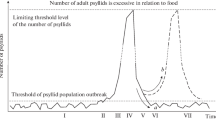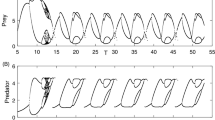Abstract
The nonlinear behavior of a particular Kolmogorov-type exploitation differential equation system assembled by May (1973,Stability and Complexity in Model Ecosystems, Princeton University Press) from predator and prey components developed by Leslie (1948,Biometrica 35, 213–245) and Holling (1973,Mem. Entomol. Soc. Can. 45, 1–60), respectively, is re-examined by means of the numerical bifurcation code AUTO 86 with model parameters chosen appropriately for a temperature dependent mite interaction on fruit trees. The most significant result of this analysis is that, in addition to the temperature ranges over which the single community equilibrium point of the system iseither globally stableor gives rise to a globally stable limit cycle, there can also exist a range wherein multiple stable states occur. These stable states consist of a focus (spiral point) and a limit cycle, separated from each other in the phase plane by an unstable limit cycle. The ecological implications of such metastability, hysteresis and threshold behavior for the occurrence of outbreaks, the persistence of oscillations, the resiliency of the system and the biological control of mite populations are discussed. It is further suggested that a model of this sort which possesses a single community equilibrium point may be more useful for representing outbreak phenomena, especially in the presence of oscillations, than the non-Kolmogorov predator-prey systems possessing three community equilibrium points, two of which are stable and the other a saddle point, traditionally employed for this purpose.
Similar content being viewed by others
Literature
Arrowsmith, D. K. and C. M. Place. 1982.Ordinary Differential Equations. London: Chapman and Hall.
Bazykin, A. D. 1974. “Volterra's System and the Michaelis-Menten Equation”. InProblems in Mathematical Genetics, V. A. Ratner (Ed.), pp 103–142. Novosibirsk: U.S.S.R. Acad. Sci.
Beddington, J. R., C. A. Free and J. H. Lawton. 1976. “Concepts of Stability and Resilience in Predator-Prey Models”.J. Anim. Ecol.,45, 791–816.
Berryman, A. A. 1987. “The Theory and Classification of Outbreaks”. InInsect Outbreaks, P. Barbosa and J. C. Schultz (Eds), pp. 3–30. New York: Academic Press.
Caughley, G. 1976. “Plant-Herbivore Systems”. InTheoretical Ecology: Principles and Applications, R. M. May (Ed.), pp. 94–113. Philadelphia: W. B. Saunders.
Danby, J. M. A. 1985.Computing Applications to Differential Equations. Reston, VA; Reston Publishing Co.
Doedel, E. J. 1984. “The Computer-Aided Bifurcation Analysis of Predator-Prey Models”.J. math. Biol. 20, 1–14.
Drazin, P. G. and W. H. Reid. 1981.Hydrodynamic Stability. Cambridge: Cambridge University Press.
Fransz, H. G. 1974.The Functional Response to Prey Density in an Acarine System (Simulation Monographs). Wageningen: Pudoc.
Hainzl, J. 1988. “Stability and Hopf Bifurcation in a Predator-Prey System with Several Parameters”.SIAM J. appl. Math. 48, 170–190.
Harrison, G. W. 1986. “Multiple Stable Equilibria in a Predator-Prey System”.Bull. math. Biol. 41, 137–148.
Hassell, M. P. 1978.The Dynamics of Arthropod Predator-Prey Systems. Princeton, NJ: Princeton University Press.
Hastings, A. and D. J. Wollkind. 1982. “Age-Structure in Predator-Prey Systems. I. A. General Model and a Specific Example”.Theor. Pop. Biol. 21, 44–56.
Holling, C. S. 1965. “The Functional Response of Predators to Prey Density and its Role in Mimicry and Population Regulation”,Mem. Entomol. Soc. Can. 45, 1–60.
—. 1973. “Resilience and Stability of Ecological Systems”.Ann. Rev. Ecol. Sys. 4, 1–23.
Huffaker, C. B., K. P. Shea and S. G. Herman. 1963. “Experimental Studies on Predation (III). Complex Dispersion and Levels of Food in an Acarine Predator-Prey Interaction”.Hilgardia 34, 305–330.
Kareiva, P. and G. M. Odell. 1987. “Swarms of Predators Exhibit ‘Preytaxis’ if Individual Predators Use Area Restricted Search”.Am. Nat. 130, 233–270.
Kolmogorov, A. N. 1936. “Sulla Teoria di Volterra della Lotta per l'Esistenza”.Gior. Instituto Ital. Attuari 7, 74–80.
Leslie, P. H. 1948. “Some Further Notes on the Use of Matrices in Population Matheamtics”.Biometrica 35, 213–245.
Logan, J. A. 1977. “Population Model of the Association ofTetranychus mcdanieli (Acarina: Tetranychidae) withMetaseiulus occidentalis (Acarina: Phytoseiidae) in the Apple Ecosystem”. Ph.D. Dissertation, Washington State University, Pullman.
Logan, J. A. 1982. “Recent Advances and New Directions inPhytoseiid Population Models”. InRecent Advances in Knowledge of the Phytoseiidae, M. A. Hoy (Ed.), pp. 49–71. Division of Agricultural Sciences Publication 3284, University of California.
— and D. W. Hilbert. 1983. “Modeling the Effect of Temperature on Arthropod Population System”. InAnalysis of Ecological Systems: State of the Art in Ecological Modeling, W. K. Lauenroth, G. V. Skogerboe and M. Flug (Eds), pp. 113–122. Amsterdam: Elsevier.
—, D. J. Wollkind, S. C. Hoyt and L. K. Tanigoshi. 1976. “An Analytic Model for Description of Temperature Dependent Rate Phenomena in Arthropods”.Envir. Entomol. 5, 1130–1140.
Lotka, A. J. 1925.Elements of Physical Biology. Baltimore: Williams and Wilkins.
Ludwig, D., D. D. Jones and C. S. Holling. 1978. “Qualitative Analysis of Insect Outbreak Systems: The Spruce Budworm and Forest”.J. Anim. Ecol. 47, 315–332.
May, R. M. 1973.Stability and Complexity in Model Ecosystems. Princeton NJ: Princeton University Press.
—. 1977. “Thresholds and Breakpoints in Ecosystems with a Multiplicity of Stable States”.Nature 269, 471–477.
—. 1981. “Models for Two Interacting Populations” InTheoretical Ecology: Principles and Applications (2nd Edn), R. M. May (ed.), pp. 78–104. Oxford: Blackwell.
Okubo, A. 1980.Diffusion and Ecological Problems: Mathematical Models. New York: Springer-Verlag.
Plant, R. E. and M. Mangel. 1987. “Modeling and Simulation in Agricultural Pest Management”.SIAM Review 29, 235–261.
Rescigno, A. and I. W. Richardson. 1967. “The Struggle for Life—I. Two Species”.Bull. math. Biophys. 29, 377–388.
— and —. 1973. “The Deterministic Theory of Population Dynamics”. InFoundations of Matheamtical Biology, R. Rosen (Ed.), pp. 283–360. New York: Academic Press.
Rosenzweig, M. L. 1971. “Paradox of Enrichment: Destabilization of Exploitation Ecosystems in Ecological Time”.Science 171, 385–387.
Sabelis, M. W. and W. E. M. Laane. 1986. “Regional Dynamics of Spider-Mite Populations That Become Extinct Locally Because of Food Source Depletion and Predation byPhytoseidd Mites”. InDynamics of Physiologically Structured Populations, J. A. J. Metz and O. Diekmann (Eds), Lecture Notes in Biomathematics. Berlin: Springer-Verlag.
— and J. van der Meer. 1966. “Local Dynamics of the Interaction between Predatory Mites and Two-Spotted Spider Mites”. InDynamics of Physiologically Structured Populations, J. A. J. Metz and O. Diekmann (Eds), Lecture Notes in Biomathematics. Berlin: Springer-Verlag.
Segel, L. A. 1972. “Simplification and Scaling”.SIAM Review 14, 547–571.
Takafuji, A., Y. Tsuda and T. Miki. 1983. “System Behavior in Predator-Prey Interaction, with Special Reference to Acarine Predator-Prey System”.Res. Popul. Ecol. Suppl.3, 75–92.
Taylor, F. 1979. “Convergence to Stable Age Distribution in Populations of Insects”.Am. Nat. 113, 511–530.
Volterra, V. 1926. “Variazioni e Fluttuazioni del Numero d'Individui in Specie Animali Conviventi”.Mem. Acad. Lincei. 2, 31–113.
Wangersky, P. J. 1978. “Lotka-Volterrra Population Models”.Ann. Rev. Ecol. Syst. 7, 189–218.
Wollkind, D. J. and J. A. Logan. 1978. “Temperature-Dependent Predator-Prey Mite Ecosystem on Apple Tree Foliage”.J. math. Biol. 6, 265–283.
Author information
Authors and Affiliations
Rights and permissions
About this article
Cite this article
Wollkind, D.J., Collings, J.B. & Logan, J.A. Metastability in a temperature-dependent model system for predator-prey mite outbreak interactions on fruit trees. Bltn Mathcal Biology 50, 379–409 (1988). https://doi.org/10.1007/BF02459707
Received:
Revised:
Issue Date:
DOI: https://doi.org/10.1007/BF02459707




